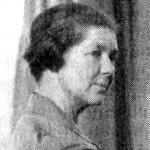Ethel Seath facts for kids
Quick facts for kids
Ethel Seath
|
|
|---|---|
 |
|
| Born | February 5, 1879 Montreal, Quebec, Canada
|
| Died | April 10, 1963 (aged 84) |
| Education | Art Association of Montreal |
| Movement | Beaver Hall Group |
Ethel Seath (February 5, 1879 – April 10, 1963) was an important Canadian artist. She was a painter, printmaker, and teacher in Montreal for sixty years. Ethel Seath often painted still life pictures and landscapes using oil and watercolour. She loved to explore colours and add abstract touches to everyday scenes.
Contents
Ethel Seath's Early Life and Art Journey
Ethel Seath was born in Montreal, Quebec, on February 5, 1879. Her family was Scottish-Presbyterian. When she was young, her family faced tough times. Her father's business struggled, and her parents later separated. To help her mother and four siblings, Ethel started working at age 17.
She began her career as a commercial illustrator for newspapers. She worked for the Montreal Witness and later the Montreal Star. At the Montreal Star, she learned a lot from famous artists. These included Arthur G. Racey and Henri Julien, who were very supportive.
Learning and Growing as an Artist
While working, Ethel also took art classes. She studied drawing with Edmond Dyonnet and lithography with J. A. Harris. Her drawing skills quickly improved. Her illustrations became a regular feature in the Weekly Star newspaper.
In 1903, Ethel was the only woman to show her art at an exhibition. This was organized by the Newspaper Artists’ Association. It showed how talented she was in a field mostly dominated by men. She was also noted as the youngest artist working in black and white.
Her success as a commercial artist allowed her to pay for more art classes. She studied at the Art Association of Montreal with William Brymner. Brymner helped her add more light and colour to her artwork. Before this, she mostly worked in black and white.
In 1911, she went on outdoor sketching trips with Maurice Cullen. These trips to the Quebec countryside helped her use bold colours. She also continued her training at the Cape Cod School of Art. There, she studied with the American painter Charles Hawthorne. Ethel began to show her own etchings, watercolours, and oil paintings.
Ethel Seath's Teaching and Art Career
In 1917, after twenty years as a newspaper illustrator, Ethel Seath started teaching art. Her friend, Margaret Gascoigne, invited her to teach at The Study. This was an all-girls private school in Montreal. Ethel taught there for 45 years.
A Creative Approach to Art Education
Ethel was a shy person, but she taught with great passion. She did not follow the old-fashioned teaching styles of her time. Instead, she had a strong personality and new ideas. She wanted to help her students be creative and explore their own ideas.
She believed that art education helps children "see, feel, and express beauty." She felt it should help them use everyday experiences in a creative way. She thought almost all children could express themselves through drawing. She believed art training made thoughts, eyes, and hands more refined.
Joining Important Art Groups
Around 1920, Ethel Seath became a founding member of the Beaver Hall Group. This group of artists was different from others at the time. It welcomed both male and female artists. They held exhibitions together and had social events. Even though the group later broke up due to money problems, many of the women artists stayed close friends.
Ethel was also a member of the Canadian Group of Painters. She showed her art in many places. These included exhibitions in Baltimore, Maryland, and at Yale University in the United States. Her work was also shown at the British Empire Exhibition in Wembley, England, in 1924 and 1925. Later, her art was at the 1939 New York World's Fair. It was also part of the A Century of Canadian Art exhibition at the Tate gallery in London, England.
Art During Challenging Times
During the Great Depression, many artists, including Ethel, needed more money. She had already faced wage cuts at The Study. To earn more, she and Anne Savage started Saturday morning modelling classes for children. These classes were held at the Art Association of Montreal in 1937.
In 1939, Ethel was chosen to be a member of the Contemporary Arts Society of Montreal. The next year, she joined the Federation of Canadian Artists. Even though she was gaining recognition, it was still hard for women artists to show their work in galleries.
Ethel realized that if women painters worked together, they would have a better chance. So, in 1940, she joined a four-woman show. She exhibited with Prudence Heward, Sarah Robertson, and Anne Savage. This show was at the Art Gallery of Toronto. She continued to participate in several more group exhibitions. These included shows at the Art Association of Montreal and the Art Gallery of Windsor. In 1950, she was part of a six-woman show at the Montreal Museum of Fine Arts.
Later Life and Legacy
In her later years, Ethel Seath spent more time caring for her ailing mother. She also had her duties at The Study school. Because of this, she slowly became less involved with the art community. However, she still held exhibitions of her work in her own home. These were supported by the Canadian Group of Painters.
Ethel retired from teaching at The Study when she was 83 years old. She continued to try new styles and techniques in her art. She kept painting until she passed away in 1963.
Remembering Ethel Seath's Art
In 1987, a special exhibition was held in Montreal. It was called the Ethel Seath Retrospective Exhibition. This show looked back at all of her amazing artwork.
Collections
Ethel Seath's art can be seen in several important collections. These include the National Gallery of Canada, the Montreal Museum of Fine Arts, and the Art Gallery of Ontario.

